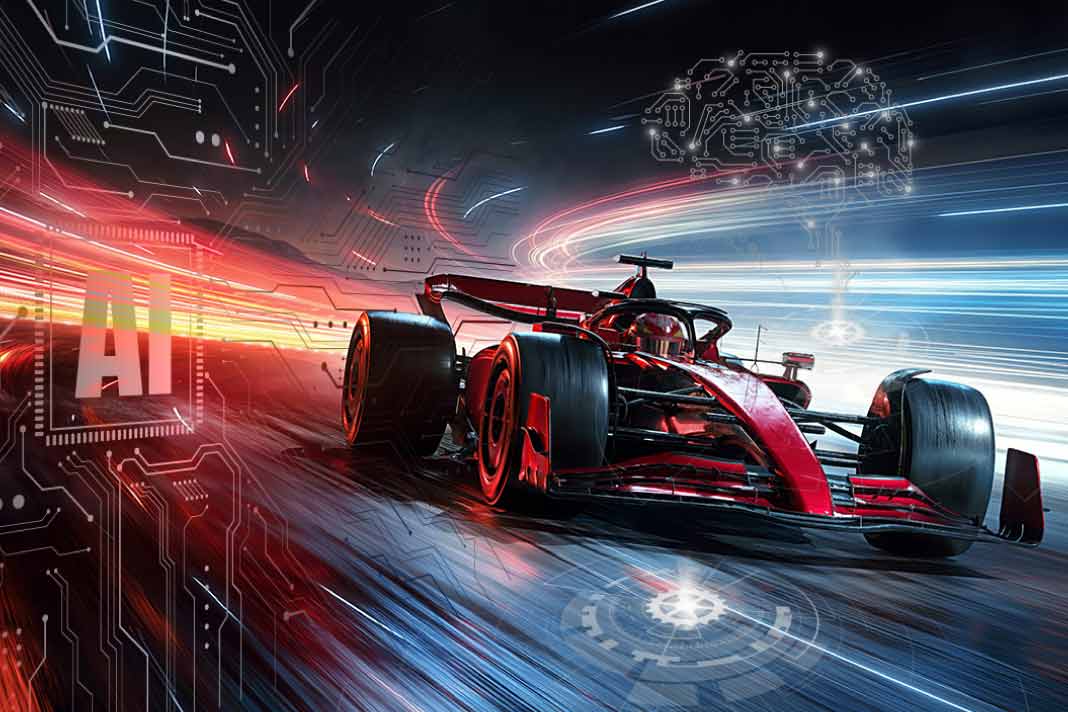AI and ML are revolutionizing Formula 1! Explore how these technologies drive race strategy, car design, and driver performance, balancing innovation with human intuition.
Formula 1 has always been at the forefront of technological innovation, and today, artificial Intelligence (AI) and machine learning (ML) stand as the newest pillars reshaping the sport. With millions of data points generated every second—from car performance telemetry to track conditions and even driver biometrics—AI and ML serve as the critical tools needed to process, analyze, and transform raw data into actionable insights. Gone are the days when success relied solely on instinct and experience. With AI-enabled simulations, predictive analytics, and continuous optimization, teams now gain a competitive edge that defines modern Formula 1.
This article, the final piece in our three-part series, explores the revolutionary role of AI and ML in Formula 1. We’ll explore how these technologies are deployed for predictive race strategy, aerodynamic design, and driver performance optimization while also pondering ethical considerations and maintaining the delicate balance between human intuition and AI automation.
AI in Action: Elevating Race Strategy to Predictive Precision
Race strategy in Formula 1 is no longer purely reactive. AI-enabled predictive analytics are helping teams anticipate future race conditions, predict competitor actions, and make decisive calls with confidence.
Proactive Planning with Predictive Analytics
Before the race even begins, AI models process years of historical race data, track-specific variables, and current conditions to forecast race scenarios. Algorithms such as decision trees, neural networks, and advanced reinforcement learning models analyze variables like tire degradation patterns, weather impacts, and overtaking likelihood. Combining machine learning tools and real-time telemetry data allows strategists to identify optimal pit windows, fuel strategies, and even anticipate safety car probabilities.
For example, Red Bull Racing has leveraged Oracle Cloud Infrastructure to run billions of simulations per weekend, analyzing scenarios such as overtaking opportunities entering high-speed corners or the optimal number of laps for a tire compound. During the 2021 Abu Dhabi Grand Prix, these capabilities came into sharp focus as Red Bull’s AI-driven insights helped engineer one of the most talked-about strategy calls in modern Formula 1—switching to fresher tires in the final moments to clinch a last-lap victory.
Pit Stop Optimization
The importance of a well-executed pit stop cannot be overstated, as the margin between a good and a bad stop is often a fraction of a second. AI is revolutionizing pit stop strategy by processing variables such as track traffic, competitor pace, tire data, and lap times in real-time. Using AI forecasting, teams can minimize time lost in the pit lane while maximizing tire performance.
By harnessing predictive analytics, decisions are no longer based merely on driver feedback or gut instinct. Teams optimize stops with near-surgical precision, and AI ensures that even unforeseen changes—like rain or track temperature shifts—can be accounted for in seconds.
Revolutionizing Car Design with AI and ML
One of the areas where AI has had the most profound influence is in car design and aerodynamics. With wind tunnel testing limited by regulations and traditional Computational Fluid Dynamics (CFD) simulations taking hours to complete, AI has emerged as an indispensable tool for accelerating innovation.
Accelerating Aerodynamic Simulations
AI platforms like Neural Concept’s “Engineering Intelligence” drastically reduce the time required for CFD simulations. These platforms use deep learning models that predict aerodynamic stability and performance much faster than classical simulation methods. For instance, Neural Concept’s technology enables teams to perform thousands of design iterations in just a few hours, fine-tuning details such as wing profiles and airflow distribution for optimal performance across various track conditions.
The reintroduction of the ground effect in Formula 1’s current regulations further highlights the role of AI. The ground effect enhances aerodynamic performance via optimal car-to-ground airflow. Finding the perfect ride height and downforce requires thousands of iterations, and AI algorithms identify the ideal design to strike this critical balance.
Pioneering Active Aero Systems
Formula 1 regulations currently limit some applications of active aerodynamics, such as the Drag Reduction System (DRS). This system, which opens a flap on the car’s rear wing to reduce drag on straights, is a crucial overtaking tool. AI contributes significantly here too, analyzing the best points on the track to deploy DRS and calculating how this impacts tire management, top speed, and energy efficiency.
By integrating prediction models into car design early on, teams now bring faster, more optimized machinery to the grid. The result? Competitive cars that adhere to stringent regulations and achieve record-breaking performance.
Enhancing Driver Performance with Machine Learning
The role of AI and ML doesn’t stop with the car—it’s also revolutionizing how teams coach and optimize driver performance.
Data-Driven Coaching
F1 teams can measure everything the driver does—from throttle pressure and gear changes to cornering speeds and brake modulation. Machine learning tools analyze this granular performance data, identifying specific areas for improvement.
For instance, after each session, drivers and engineers pore over performance telemetry to review their lap times, speed traces, and braking zones. Using ML algorithms, teams can simulate alternative driving strategies and present feedback to the driver in a format that’s actionable. This transforms subjective feedback into concrete data points, enabling drivers to fine-tune their performance corner by corner.
Biometric Feedback
An exciting development in Formula 1 is integrating biometric data into driver performance strategies. AI tools analyze driver stress levels, heart rate, and blood oxygen saturation in real time, offering insights into physical and mental performance under varying conditions. By correlating this data with performance telemetry, teams can understand how a driver’s physiological state impacts decision-making, reaction times, and overall focus during crucial race moments.
Further advancement in wearable technology—such as helmets with embedded sensors—could provide even deeper insights into driver well-being and fatigue management, further enhancing on-track performance.
Navigating Ethical Complexities in AI Integration
While AI and ML have undoubtedly brought exciting innovations to Formula 1, their integration poses several ethical and strategic questions for the sport.
The Human-AI Balance
One central concern is whether the increasing reliance on AI risks sidelining human intuition and adaptability. Racing at its core is about the driver’s skill, quick thinking, and ability to adapt in real time. Should AI systems dictate too much, the fear is that Formula 1 could lose some of its unpredictable and thrilling character.
Industry leaders maintain, however, that AI functions as an augmentation tool rather than a replacement for human decision-making. Teams continue to pair data insights with the instinct and experience of drivers, strategists, and engineers—a collaboration that ensures AI complements rather than overwhelms human expertise.
Data Privacy and Security
Formula 1 teams manage vast amounts of sensitive data, from proprietary design schematics to biometric telemetry. A potential leak of such information could give competitors an unfair advantage, raising the stakes for cybersecurity and the ethical use of sensitive data across the grid.
Disparities Between Teams
The cost of implementing AI systems remains a significant hurdle for smaller teams. While well-funded organizations like Mercedes or Red Bull enjoy access to state-of-the-art AI platforms, mid-tier and lower-budget teams often struggle to invest similarly. The FIA, Formula 1’s governing body, faces ongoing pressure to ensure that AI adoption doesn’t widen the gap between teams, threatening the grid’s competitiveness.
Closing Thoughts
Artificial intelligence and machine learning are not just tools—they are game-changers in Formula 1. From enabling predictive race strategies and advancing aerodynamic processes to revolutionizing driver performance optimization, AI’s integration is driving unprecedented innovation in the sport. Yet, as Formula 1 advances, the sport must continually navigate the fine line between technological innovation and the human spirit that has defined racing for decades.
AI and machine learning empower teams to predict outcomes, optimize every detail of car design, and unlock new driver performance levels. Their transformative impact enables engineers and strategists to make decisions backed by data, run complex simulations in real time, and adapt to changing race conditions with agility never before possible.
Yet, Formula 1’s essence remains a dynamic blend of cutting-edge technology and human intuition. While algorithms can suggest ideal strategies and uncover marginal gains, it is still the creativity, instinct, and courage of the people behind the wheel—and in the pits—that fuel the sport’s excitement and unpredictability.
As AI and ML’s roles continue to grow, the challenge will be harnessing these tools to complement, not replace, human expertise. Formula 1’s ultimate success will rest in its ability to strike this balance—ensuring that as the machines get smarter, the heart of racing stays human.



